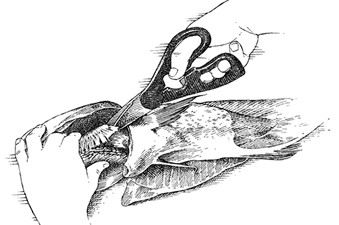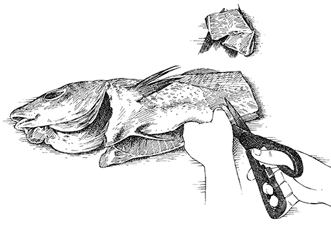The Cook's Illustrated Cookbook (32 page)
Read The Cook's Illustrated Cookbook Online
Authors: The Editors at America's Test Kitchen
Tags: #Cooking

MAKES ABOUT 8 CUPS
To defat hot stock, we recommend using a ladle or fat separator. Alternatively, after the stock has been refrigerated, the fat hardens on the surface and is very easy to remove with a spoon.
1 | tablespoon vegetable oil |
1 | onion, chopped |
4 | pounds whole chicken legs or backs and wingtips, cut into 2-inch pieces |
8 | cups boiling water |
¹⁄ | teaspoon salt |
2 | bay leaves |
1.
Heat oil in stockpot or Dutch oven over medium-high heat until shimmering. Add onion and cook until slightly softened, 2 to 3 minutes. Transfer to large bowl. Brown chicken in 2 batches, cooking on each side until lightly browned, about 5 minutes per side. Transfer to bowl with onion.
2.
Return onion and chicken to pot. Reduce heat to low, cover, and sweat until chicken releases its juices, about 20 minutes. Increase heat to high and add boiling water, salt, and bay leaves. Bring to boil, then reduce heat to low, cover, and simmer slowly until stock is rich and flavorful, about 20 minutes, skimming foam off surface if desired.
3.
Strain stock, discard solids. Before using, defat stock. (Stock can be refrigerated for up to 4 days or frozen for up to 6 months.)
![]() WHY THIS RECIPE WORKS
WHY THIS RECIPE WORKS
To develop a rich beef stock, we made six stocks with six different cuts of beef, adding marrowbones to the boneless cuts to establish an equal meat-to-bone ratio in each pot. Tasters liked the stock made from shanks best, though beef chuck also worked well. In addition to using the right cut, we found the best stock is made with lots of beef. Most recipes skimp, but we found a full 6 pounds of shanks was required to make 8 cups of rich-tasting stock. To extract maximum flavor and body from the meat and bones, we discovered beef stock must be simmered much longer than chicken stock. Red wine, used to deglaze the pan after browning the beef, added an extra layer of flavor.
MAKES 8 CUPS
To defat hot stock, we recommend using a ladle or fat separator. Alternatively, after the stock has been refrigerated, the fat hardens on the surface and is very easy to remove with a spoon. Make sure to use 6-quart or larger stockpot or Dutch oven for this recipe.
2 | tablespoons vegetable oil |
1 | large onion, chopped |
6 | pounds beef shanks, meat cut from bone in large chunks, or 4 pounds beef chuck, cut into 3-inch chunks, and 2 pounds small marrowbones |
¹⁄ | cup dry red wine |
8 | cups boiling water |
¹⁄ | teaspoon salt |
2 | bay leaves |
1.
Heat 1 tablespoon oil in stockpot or Dutch oven over medium-high heat until shimmering. Add onion and cook, stirring occasionally, until slightly softened, 2 to 3 minutes. Transfer to large bowl.
2.
Brown meat and bones on all sides in 3 or 4 batches, about 5 minutes per batch, adding remaining oil to pot as necessary; do not overcrowd. Transfer to bowl with onion. Add wine to pot and cook, scraping up browned bits with wooden spoon, until wine is reduced to about 3 tablespoons, about 2 minutes. Return browned beef and onion to pot, reduce heat to low, cover, and sweat until meat releases juices, about 20 minutes. Increase heat to high, add boiling water, salt, and bay leaves. Bring to boil, then reduce heat to low, cover, and simmer slowly until meat is tender and stock is flavorful, 1¹⁄
2
to 2 hours, skimming foam off surface. Strain and discard bones and onion; reserve meat for another use, if desired.
3.
Before using, defat stock. (Stock can be refrigerated for up to 4 days or frozen for up to 6 months.)
![]() WHY THIS RECIPE WORKS
WHY THIS RECIPE WORKS
Unlike long-simmering chicken or beef stews, fish stews (and soups) typically cook for a short period, so using a full-flavored homemade fish stock can make a big difference. Fish bones are key for flavoring stock as well as adding viscosity, and we tested a wide variety of fish to see which worked and which didn’t. Bones from mild white fish worked best, while those from oily fish had an overpowering flavor. We found that sweating the vegetables tended to cloud the stock’s flavors, so we simply brought all the ingredients to a simmer and added wine for some acidity. For those times when we didn’t want to fuss with making old-fashioned fish stock, we found that doctoring clam juice was a good stand-in and took just half an hour to prepare.
See “CLEANING FISH FRAMES FOR STOCK” illustrations that follow recipe.
MAKES ABOUT 8 CUPS
You can often buy fish frames (skeletons)
cheaply at your local fish market, or ask for them at the fish counter of your local supermarket. We like frames from mild white fish the most. Note that the type of fish bones you use can make a big difference in the flavor of the stock; see below for more information.
Make sure to use 6-quart or larger stockpot or Dutch oven for this recipe.
2 | tablespoons unsalted butter |
3 | pounds fish frames, cleaned |
2 | onions, chopped |
1 | large celery rib, chopped coarse |
5 | ounces white mushrooms, trimmed and quartered |
¹⁄ | ounce dried porcini mushrooms, rinsed (optional) |
5 | garlic cloves, peeled and smashed |
1³⁄ | cups dry white wine |
8 | cups water |
6 | sprigs fresh parsley |
5 | sprigs fresh thyme |
2 | teaspoons salt |
8 | whole black peppercorns |
2 | bay leaves |
1.
Melt butter in stockpot or Dutch oven over high heat. Add fish frames, onions, celery, white mushrooms, porcini mushrooms, if using, and garlic, cover, and cook, stirring occasionally, until fish frames have begun to release some liquid, 6 to 8 minutes.
2.
Reduce heat to medium and continue to cook, covered, stirring often with wooden spoon to break apart fish frames, until vegetables and bones are soft and aromatic, 6 to 8 minutes longer.
3.
Add wine, cover, and simmer gently for 10 minutes. Add water, parsley, thyme, salt, peppercorns, and bay leaves. Return to gentle simmer and cook, uncovered, skimming as needed, until stock tastes rich and flavorful, about 30 minutes longer.
4.
Strain stock through fine-mesh strainer, then defat stock. (Stock can be refrigerated for up to 4 days or frozen for up to 1 month.)
MAKES ABOUT 4 CUPS
Clam juice is very salty so don’t add salt to this stock until after you add the clam juice and taste it.
1 | small onion, chopped |
1 | carrot, chopped |
1 | celery rib, chopped |
8 | sprigs fresh parsley |
1 | cup dry white wine |
6 | (8-ounce) bottles clam juice |
2 | bay leaves |
8 | whole black peppercorns |
¹⁄ | teaspoon dried thyme |
Salt |
Bring all ingredients to boil in medium saucepan and simmer to blend flavors, about 30 minutes. Strain stock through cheesecloth, pressing on solids with back of spoon to extract as much liquid as possible. Season with salt to taste. Use immediately.

1.
Lift gill cover and detach gills with kitchen shears.

2.
Remove and discard gills. Rinse fish frame under cool running water.

3.
Cut fish frame into small pieces that will easily fit into stockpot.
![]() WHY THIS RECIPE WORKS
WHY THIS RECIPE WORKS
We wanted a nicely balanced, robust stock that vegetarians and nonvegetarians alike would consider making. Caramelizing plenty of onion, shallot, and garlic was a great start to ensuring depth and a sweetness that wasn’t one-dimensional. Then we tossed in a few nontraditional ingredients—cauliflower, collard greens, lemon grass, and scallions—to add complexity. Finally, finishing with a splash of rice vinegar produced a full-flavored stock that could stand on its own.
See “BRUISING LEMON GRASS” illustration that follows recipe.
